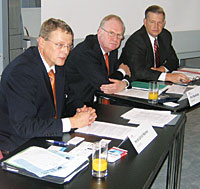Developments announced at the 26th annual International Trade Fair for Refrigeration, Air Conditioning and Ventilation (IKK) included:
Retrofitting HFCs
Mark Baunchalk, global business manager for DuPont, described the Isceon® 9 Series as an "easy-to-use, nonozone-depleting retrofit option for a variety of air conditioning and refrigeration applications." DuPont officials said the company offers guidance as to the best applications for the line of HFCs.The new Web site (www.refrigerants.dupont.com) has customized sections for OEMs, distributors, service technicians, and end users. It includes technical and product information, product selection tools, environmental and regulatory updates, and training materials.
Phil Bardsley, business manager for DuPont's refrigerants business in Europe, the Middle East, and Africa, reported on the company's efforts to help developing countries (those still allowed to use CFCs) to move directly to HFCs without an interim step of using HCFCs. "There is not a need this time for those countries switching from CFCs to go to transitional substances that are still ozone depleting," he said.
FX 100
Arkema officials described FX 100 as a retrofit option for R-22 air conditioning and refrigeration systems. "Optimum performance similar to R-22 is achieved without the need for a through-rinse of the circuit thanks to a high tolerance to residual mineral or alkylbenzene oil," the company said.
Officials said the product is expected to be available only in Europe. They also said they would seek a designation for the refrigerant from the American Society of Heating, Refrigerating and Air-Conditioning Engineers (ASHRAE).

HFCs In Europe
Uses of HFC refrigerants in Europe are governed by regulations from the European Union (made up of representatives of 25 member countries). Environmentalists (Greens) put periodic pressure on regulators to put more limitations on the use of HFCs because of global warming.Meanwhile, the HVACR industry in Europe argues that responsible use and containment can negate global warming concerns.
According to an announcement made at IKK by refrigerant manufacturer Solvay, on Oct. 26 the European Parliament voted in a way "that can be considered very positive for all commercial sectors, as fluorinated gases (such as HFCs) can be used in all their essential applications into the future."
The manufacturer noted that there still are concerns over the ability of some individual countries (currently Austria and Denmark) to impose stricter regulations in their own countries; the HVACR industry wants a Europe-wide standard.
"Nevertheless, the positive effects of the voting results on the industry sectors involved, as well as the environment - by maintaining the freedom to use the most appropriate fluid with regard to energy efficiency and safety - as a whole, by far outweigh the few weak points in the voting results."
The significance of such developments in Europe to North America comes from a historical context; it was in Europe that bans on the use of CFCs and HCFCs first arose, eventually spreading to North America.
Compressor Considerations
Eckhard Groll of the Purdue School of Mechanical Engineering presented a paper that included a summarization of a wide range of studies as to how various types of compressors could work with CO2.For example, one study said "that the reciprocating compressor design is most promising (for leakage reduction) since the gap length between the cylinder and the piston can be reduced by increasing the stroke-to-bore ratio."
In a project involving a two-stage, rotary-type compressor, "the design idea was to implement two stages, which both are equal to an R-410A compressor stage. Therefore, the leak problem is circumvented since the differential pressure of each stage is reduced to half of the total pressure difference."
In a scroll compressor test, "the volumetric efficiency increases with increased speed ... that drop in volumetric efficiency due to the large pressure differences is less significant - compared to an HFC-410A scroll compressor - than expected."
Publication date: 12/05/2005


Report Abusive Comment